Detarium
| Detarium | ||||||||||||
|---|---|---|---|---|---|---|---|---|---|---|---|---|

Detarium senegalense , illustration of inflorescences and fruit |
||||||||||||
| Systematics | ||||||||||||
|
||||||||||||
| Scientific name | ||||||||||||
| Detarium | ||||||||||||
| Yuss. |
Detarium is a genus of plants in the subfamily of the carob family (Caesalpinioideae) within the legume family (Fabaceae). The threeor sospecies arenative totropical Africa and are used in many ways.
Description and ecology


The Detarium species grow as trees or bushes . They contain resin . The alternate leaves arranged on the branches are divided into a petiole and a leaf blade. The leaf blade is unpaired or alternately pinnate. The short-stalked leaflets with pinnate veins have many glands on the lamina. The leaf margin is whole.
The flowers are grouped in the leaf axils in paniculate to racemose inflorescences. The cover sheets fall off. The hermaphroditic flowers are usually four-fold with a double flower envelope. There are no petals. There is no discus. There is only one carpel , the ovary is more or less hairy and has a short stalk and is superordinate. The drupes (or drupes-like legumes ), which are brownish to blackish when ripe, have a diameter of about 5-8 centimeters and a two-part, green, fibrous to fibrous-woody pulp . The diaspores are spread by animals that eat the fruit.
Systematics and distribution
The genus Detarium was established by the French botanist Antoine Laurent de Jussieu in 1789 in Genera plantarum p. 365. The generic name Detarium is derived from "detar", the name the Wolof use for these plants.
The genus Detarium belongs to the tribe Detarieae in the subfamily Caesalpinioideae within the family Fabaceae .
The three Detarium species are common in tropical western and western-central Africa. The southernmost natural occurrence is in the Congo near Kinshasa .
There are about three types of Detarium :
- Detarium macrocarpum Harms : It occurs in Cameroon , Gabon and Nigeria .
- Detarium microcarpum Guill. & Perr. : It is common in Cameroon, the Central African Republic , Chad , Ghana , Guinea , Guinea-Bissau , Ivory Coast , Mali , Niger , Nigeria, Senegal , Sudan , Gambia and Togo .
- Detarium senegalense J.F. Gmel. (Syn. Detarium heudelotianum Baill. ): It is common in the Central African Republic, Ghana, Guinea, Guinea-Bissau, the Ivory Coast, Liberia , Nigeria, Senegal, Sudan, Sierra Leone and Gambia.
use
The very vitamin C-rich stone fruit of Detarium senegalense is eaten or made into a green juice drink.
The wood from Detarium senegalense is mainly used for cabinet making as well as for veneers and parquet.
swell
- Datasheet from Legumes of the World by the Board of Trustees of the Royal Botanic Gardens, Kew.
- Margaret Steentoft: Flowering Plants in West Africa . Cambridge University Press, 1988, ISBN 978-0-521-26192-0 , pp. 139 ( Detarium on p. 139 in the Google book search). (Section description)
Individual evidence
- ↑ a b Data sheet from Legumes of the World of the Board of Trustees of the Royal Botanic Gardens, Kew. ( Memento of the original from September 9, 2015 in the Internet Archive ) Info: The archive link was inserted automatically and has not yet been checked. Please check the original and archive link according to the instructions and then remove this notice.
- ^ A b c Margaret Steentoft: Flowering Plants in West Africa . Cambridge University Press, 1988, ISBN 978-0-521-26192-0 , pp. 139 ( Detarium on p. 139 in the Google book search).
- ^ Detarium at Tropicos.org. Missouri Botanical Garden, St. Louis, accessed on May 28, 2015.
- ↑ a b c Detarium in the Germplasm Resources Information Network (GRIN), USDA , ARS , National Genetic Resources Program. National Germplasm Resources Laboratory, Beltsville, Maryland.
- ↑ a b c d Detarium. ILDIS = International Legume Database & Information Service - LegumeWeb from World Database of Legumes , Version 10.01. dated November 2005.
further reading
- Peter Achunike Akah, Chukwuemeka Sylvester Nworu, Florence Nwakaego Mbaoji, Ifeoma Amarachukwu Nwabunike, Collins Azubuike Onyeto: Genus Detarium: Ethnomedicinal, phytochemical and pharmacological profile. In: Phytopharmacology , 2012, Volume 3, Issue 2, pp. 367-375. Full text PDF.
Web links
- Detarium . In: U. Brunken, M. Schmidt, S. Dressler, T. Janssen, A. Thiombiano, G. Zizka: West African plants - A Photo Guide. Senckenberg Research Institute, Frankfurt am Main 2008.